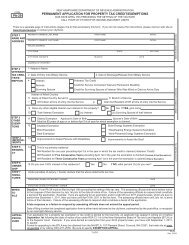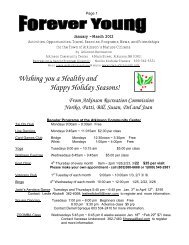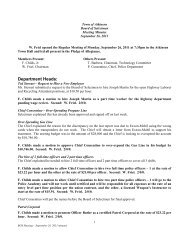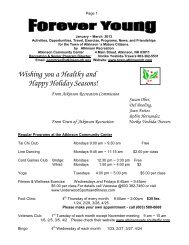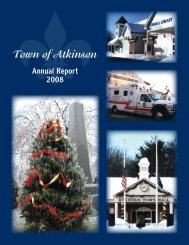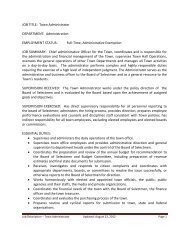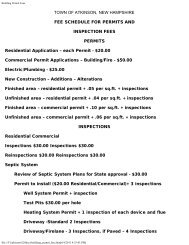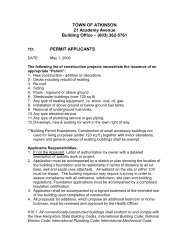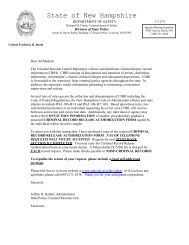Carbon Monoxide Poisoning and Prevention - Capital Area Public ...
Carbon Monoxide Poisoning and Prevention - Capital Area Public ...
Carbon Monoxide Poisoning and Prevention - Capital Area Public ...
You also want an ePaper? Increase the reach of your titles
YUMPU automatically turns print PDFs into web optimized ePapers that Google loves.
Warm Weather <strong>Carbon</strong><strong>Monoxide</strong> Hazards• Gas or charcoal grill usedinside an enclosed area.• Gas-powered tools (lawnmower, generator, chainsaw) run in a home, garage, orunder a tarp.• Gas-fueled lanterns <strong>and</strong>stoves used inside a small,sealed area like a tent, trailer,or boat cabin.• “Teak surfing” or pulling“skiers” from a boat’s divingplatform.• Diving from or swimming nearhouseboat platforms while motor isrunning.• An improperly installed or poorlyfunctioning gas- or keroseneburningappliance.To report a dangerousproduct or a product-relatedinjury:Call the Consumer Product SafetyCommission’s toll-free hotline at1-800-638-2772 (TTY available at1-800-638-8270) or e-mail atinfo@cpcs.gov.Call theNorthern New Engl<strong>and</strong>Poison Center1-800-222-1222Voice/TTY/Interpretation Services AvailableRelay Service: 7-1-1Poison Emergencies<strong>Prevention</strong> QuestionsMedication Safety24hrs ● Free ● Confidentialwww.nnepc.orgThe NNEPC is supported by: Maine Medical Center, a memberof the MaineHealth Family; Maine Center for Disease Control<strong>and</strong> <strong>Prevention</strong>, Department of Health <strong>and</strong> Human Services;The United Way; New Hampshire Department of Safety;Vermont Department of Health; Fletcher Allen Health Care.The NNEPC is also supported by funds received throughgrant # H4BHS00078 awarded by the Department of Health<strong>and</strong> Human Services, Health Resources <strong>and</strong> ServicesAdministration. Its contents are solely the responsibility of theauthors <strong>and</strong> do not necessarily represent the official views ofthe Health Resources <strong>and</strong> Services Administration, Division ofHealthcare Preparedness, Healthcare Systems Bureau.<strong>Carbon</strong> <strong>Monoxide</strong><strong>Poisoning</strong> <strong>and</strong><strong>Prevention</strong><strong>Carbon</strong> monoxide prevents oxygenfrom being carried in the blood.The “Invisible” KillerYou cannot see orsmell carbon monoxide --but at high levels itcan kill you in minutes.Northern New Engl<strong>and</strong>Poison Center
<strong>Carbon</strong> monoxide is a colorless,odorless, poisonous gas.It enters the body through the lungs,<strong>and</strong> is delivered to the blood. Itprevents the blood from carrying <strong>and</strong>using oxygen properly, <strong>and</strong> harmsthe brain <strong>and</strong> other organs.<strong>Carbon</strong> monoxide is made whenfuels burn improperly. Many fuelscan produce carbon monoxide, suchas:• Wood• Oil• Natural gas• Gasoline• Kerosene• Propane• CoalSymptoms<strong>Carbon</strong> monoxide poisoning beginswith flu-like symptoms They include:• Headache• Fatigue• Shortness of breath• Nausea• DizzinessRisk of <strong>Poisoning</strong>• When appliances, equipment, orheating systems burn fuel, there isrisk of carbon monoxide poisoning ifthey are not working properly.(Electric appliances <strong>and</strong> electricheating systems do not producecarbon monoxide.)• If the appliances <strong>and</strong> equipmentdo not function as they should, haveworn parts, or are vented improperly,there is great risk for carbonmonoxide poisoning.<strong>Carbon</strong> <strong>Monoxide</strong> EmergencyIf you suspect that you have beenexposed to carbon monoxide:• Get to fresh air right away.• Call 911 or local fire department.• Call the Northern New Engl<strong>and</strong>Poison Center at 1-800-222-1222.<strong>Prevention</strong> Tips• Have appliances <strong>and</strong> heatingsystems installed by a professional.• Place carbon monoxidealarms close to sleeping areas.Place extra alarms on every level<strong>and</strong> in every bedroom of a home formore protection.• Check battery-operated carbonmonoxide alarms monthly <strong>and</strong>replace batteries according to themanufacturer’s instructions or whenbatteries are low.• Never run a portable generatorunder windows or indoors, includinggarages, basements <strong>and</strong>crawlspaces.• Never burn charcoal inside ahome, garage, closed-in porch,vehicle or tent unless properlyvented to the outside.• Never leave a car running in agarage, even with the garage dooropen.• Have your furnace <strong>and</strong> chimneycleaned byprofessionals oncea year beforeheating season.




